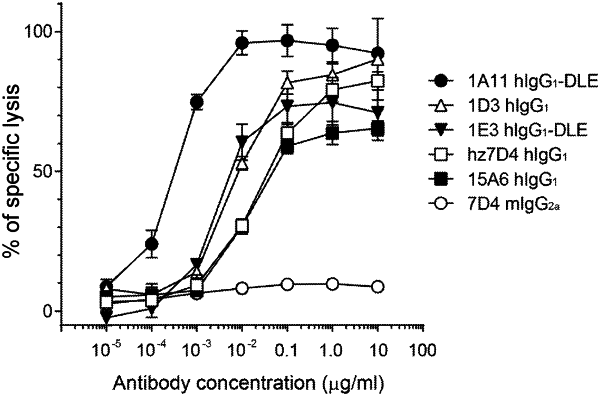| CPC C07K 16/2803 (2013.01) [A61P 35/00 (2018.01); A61K 45/06 (2013.01); C07K 2317/565 (2013.01); C07K 2317/567 (2013.01)] | 33 Claims |

|
1. An isolated antibody or antigen-binding fragment that specifically binds to human T cell immunoglobulin and ITIM domain (TIGIT), wherein the antibody or antigen-binding fragment comprises:
(a) three heavy chain complementarity determining regions (HCDRs) comprising amino acid sequences of SEQ ID NO: 1 (HCDR1), SEQ ID NO: 2 (HCDR2), and SEQ ID NO: 3 (HCDR3); and three light chain complementarity determining regions (LCDRs) comprising amino acid sequences of SEQ ID NO: 4 (LCDR1), SEQ ID NO: 5 (LCDR2), and SEQ ID NO: 23 (LCDR3);
(b) three heavy chain complementarity determining regions (HCDRs) comprising amino acid sequences of SEQ ID NO: 1 (HCDR1), SEQ ID NO: 2 (HCDR2), and SEQ ID NO: 3 (HCDR3); and three light chain complementarity determining regions (LCDRs) comprising amino acid sequences of SEQ ID NO: 4 (LCDR1), SEQ ID NO: 5 (LCDR2), and SEQ ID NO: 24 (LCDR3);
(c) three heavy chain complementarity determining regions (HCDRs) comprising amino acid sequences of SEQ ID NO: 1 (HCDR1), SEQ ID NO: 2 (HCDR2), and SEQ ID NO: 3 (HCDR3); and three light chain complementarity determining regions (LCDRs) comprising amino acid sequences of SEQ ID NO: 4 (LCDR1), SEQ ID NO: 5 (LCDR2), and SEQ ID NO: 6 (LCDR3);
(d) three heavy chain complementarity determining regions (HCDRs) comprising amino acid sequences of SEQ ID NO: 1 (HCDR1), SEQ ID NO: 2 (HCDR2), and SEQ ID NO: 19 (HCDR3); and three light chain complementarity determining regions (LCDRs) comprising amino acid sequences of SEQ ID NO: 4 (LCDR1), SEQ ID NO: 5 (LCDR2), and SEQ ID NO: 6 (LCDR3);
(e) three heavy chain complementarity determining regions (HCDRs) comprising amino acid sequences of SEQ ID NO: 1 (HCDR1), SEQ ID NO: 2 (HCDR2), and SEQ ID NO: 20 (HCDR3); and three light chain complementarity determining regions (LCDRs) comprising amino acid sequences of SEQ ID NO: 4 (LCDR1), SEQ ID NO: 5 (LCDR2), and SEQ ID NO: 6 (LCDR3);
(f) three heavy chain complementarity determining regions (HCDRs) comprising amino acid sequences of SEQ ID NO: 1 (HCDR1), SEQ ID NO: 2 (HCDR2), and SEQ ID NO: 21 (HCDR3); and three light chain complementarity determining regions (LCDRs) comprising amino acid sequences of SEQ ID NO: 4 (LCDR1), SEQ ID NO: 5 (LCDR2), and SEQ ID NO: 6 (LCDR3);
(g) three heavy chain complementarity determining regions (HCDRs) comprising amino acid sequences of SEQ ID NO: 7 (HCDR1), SEQ ID NO: 8 (HCDR2), and SEQ ID NO: 9 (HCDR3); and three light chain complementarity determining regions (LCDRs) comprising amino acid sequences of SEQ ID NO: 10 (LCDR1), SEQ ID NO: 11 (LCDR2), and SEQ ID NO: 12 (LCDR3); or
(h) three heavy chain complementarity determining regions (HCDRs) comprising amino acid sequences of SEQ ID NO: 13 (HCDR1), SEQ ID NO: 14 (HCDR2), and SEQ ID NO: 15 (HCDR3); and three light chain complementarity determining regions (LCDRs) comprising amino acid sequences of SEQ ID NO: 16 (LCDR1), SEQ ID NO: 17 (LCDR2), and SEQ ID NO: 18 (LCDR3).
|